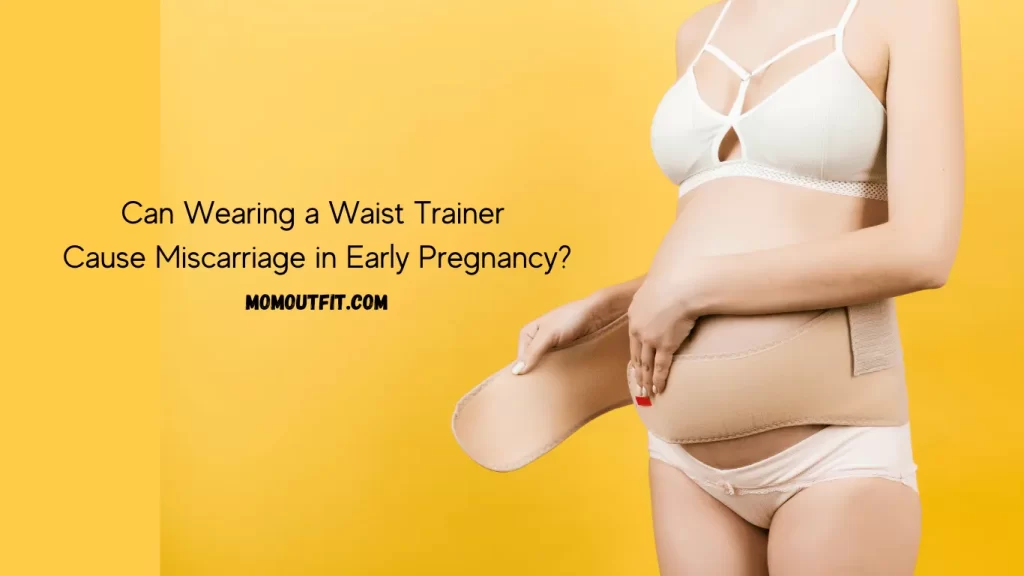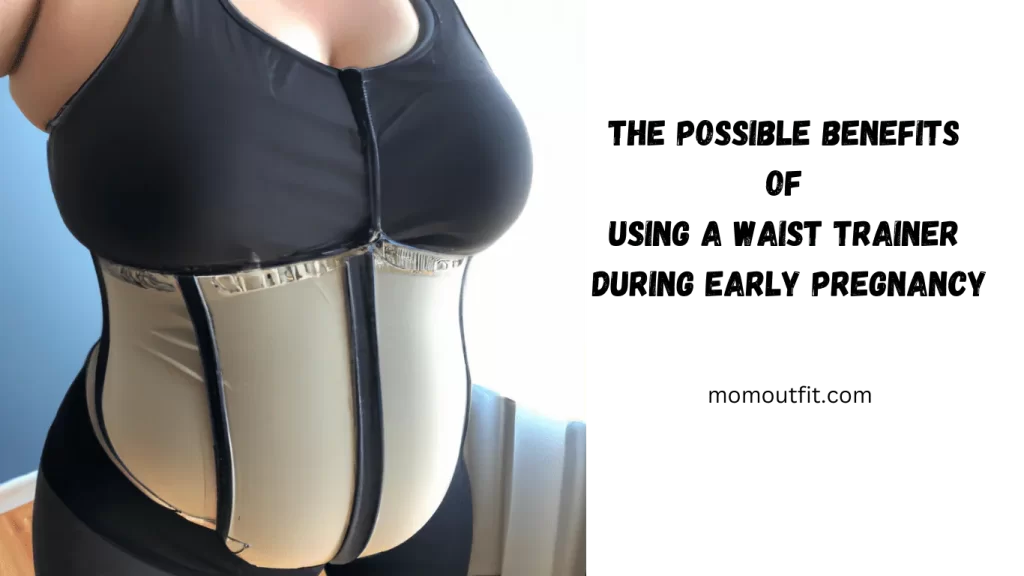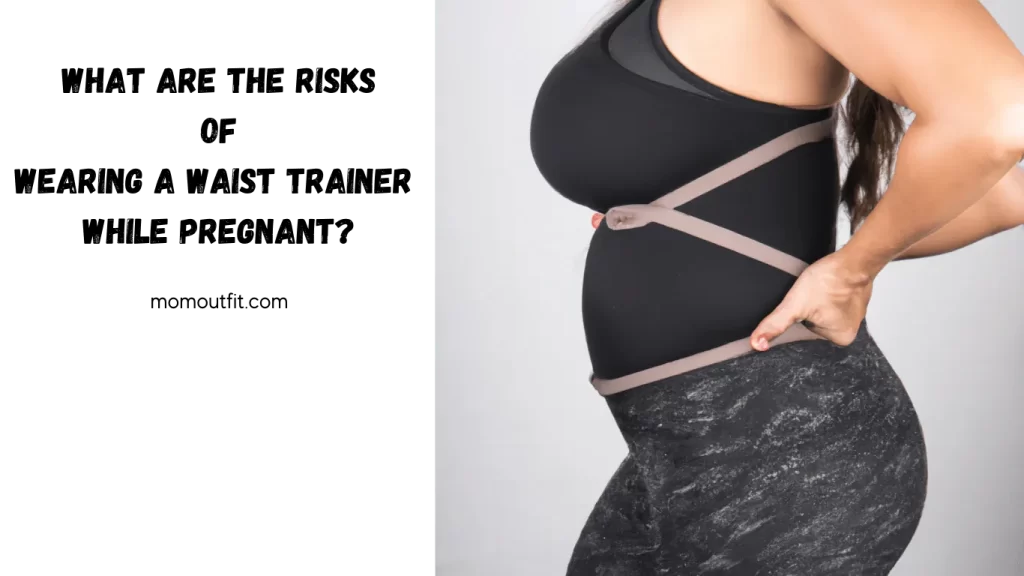It’s a common question among expecting mothers: can wearing a waist trainer cause a miscarriage in early pregnancy?
Wearing a waist trainer during pregnancy, especially during the first trimester, is not recommended. It can compress the stomach, waist, and abdomen, directly affecting the uterus and restricting the baby’s growth. Additionally, it can put pressure on the bladder, causing urinary incontinence and reducing lung capacity, leading to dizziness, fainting, fluid buildup, and inflammation.
Waist trainers have recently become popular to slim the waist and improve posture. However, some concern is that wearing one during pregnancy could put unnecessary pressure on the abdomen. Also, it may potentially harm the developing baby.
In this blog post, I will explore the potential risks of wearing a waist trainer during pregnancy and guide what to consider before using one. You will also get an overview of the potential risks of wearing a waist trainer during pregnancy. As a bonus offer, I will add some tips on how to minimize these risks.

What is a waist trainer?
A waist trainer is a garment worn around the waist to slim and shape the midsection. It is typically made of a flexible material worn tightly around the waist. Likewise, some versions may include steel boning to help provide added support and structure.
Waist trainers are often worn for extended periods. The goal is to reduce the waistline and create a more hourglass-like figure gradually.
The connection between waist trainers and pregnancy comes from many women wearing their trainers while pregnant. It can be incredibly tempting in the early stages of pregnancy when the baby is still tiny and the waist is not yet visibly enlarged.
However, there is some concern that wearing a waist trainer during pregnancy could put unnecessary pressure on the abdomen and harm the developing baby. Doctors and other medical professionals have raised concerns about the potential risks of wearing a waist trainer during pregnancy.
How does a waist trainer work for a regular woman and a mother-to-be?
A waist trainer applies pressure to the midsection, which helps compress the waist and create a slimmer, more hourglass-like shape. The garment is typically worn tightly around the waist. It may include steel boning or other types of support to help provide structure and support.
The goal is to reduce the waistline gradually over time. Many people using waist trainers report a noticeable difference in shape after a few weeks of regular use.
For a regular woman, a waist trainer can be a valuable tool to help shape and slim the waist. However, using it properly and not wearing it too tightly is vital, as this could cause discomfort or harm. It is also important to remember that it is not a substitute for regular exercise and a healthy diet. It should also not be relied upon as a quick fix for weight loss.
For a mother-to-be, the use of a waist trainer is more controversial. While some women continue to wear their waist trainers throughout pregnancy, there is concern that this could put unnecessary pressure on the abdomen and potentially harm the developing baby.
It is generally recommended to avoid using a waist trainer during pregnancy, as the growing baby and uterus need space to develop and grow. Alternatively, a waist trainer could potentially restrict this space and cause harm.
The added pressure on the abdomen could cause discomfort and even pain for the mother. If you are pregnant and considering using a waist trainer, it is best to consult your doctor first.
Can Wearing a Waist Trainer Cause Miscarriage in Early Pregnancy?
Wearing a waist trainer cannot cause a natural miscarriage in early pregnancy. However, it is essential to note that waist trainers should be avoided during pregnancy due to the potential health risks that they can cause.
Miscarriage(spontaneous abortion) is spontaneous pregnancy loss before the 20th week. It is common, with estimates suggesting that up to 25% of all pregnancies end in miscarriage. The causes of miscarriage are not well understood. However, doctors believe it is due to genetic and environmental factors.
Waist trainers are designed to snap the waist and create an hourglass figure. It is done by compressing the abdominal area and putting pressure on the uterus. This pressure can lead to discomfort. Hence, it can even cause the uterus to become compressed, which leads to reduced blood flow to the fetus. Also, it can cause the fetus to become malnourished. It can increase the risk of miscarriage in later pregnancy stages.
In addition, waist trainers can also cause other health issues during pregnancy. The pressure from the waist trainer can lead to increased chances of dehydration, as well as a decrease in circulation. It can cause the uterus to become stressed, leading to contractions and even preterm labor.
It is important to note that wearing a waist trainer cannot cause a miscarriage in early pregnancy. Still, it is essential to avoid it during pregnancy. Instead, practicing safe pregnancy habits such as eating a balanced diet, getting adequate rest, avoiding strenuous activities, and wearing comfortable clothing is essential. These habits will help ensure both mother and baby stay healthy during pregnancy.
I suggest you consult your doctor before making any decisions that affect your or your baby’s health.
The Possible Benefits of Using a Waist Trainer During Early Pregnancy
Many women may choose to continue wearing their waist trainers during this time. However there is a debate about whether it is safe or beneficial. The potential risks of wearing a waist trainer during pregnancy may outweigh any potential benefits.

However, there are some potential benefits to using a waist trainer during early pregnancy. But it’s essential to consult a doctor first to ensure it’s safe. Some of the benefits of wearing waist trainers during pregnancy are here:
Supporting Growing Belly
Wearing a waist trainer can provide support for your growing belly. As your baby grows, your stomach will expand, and your muscles will become weaker and less able to support your baby. A waist trainer can help provide additional support and keep your stomach muscles in place.
Reduced Back Pain
It helps in back pain reduction. Baby grows gradually, and the extra weight can cause your back to become strained and painful. A waist trainer can help provide additional support for your back and help to reduce the strain.
Enhances Posture
When you’re pregnant, your body goes through significant changes – your center of gravity shifts higher up in your body, your ligaments stretch significantly (which can make you feel unstable), and your feet swell exponentially. All these changes can lead to poor posture and chronic pain throughout the rest of your life. A waist trainer can help correct these problems early in pregnancy, reducing the risk of chronic pain later.
Reduced belly fat
A study published in The Journal of Obesity found that women who used waist trainers lost more weight and had less abdominal fat than those who didn’t. It was likely because waist trainers work by restricting your breathing, which leads to reduced calorie intake and increased burning of calories.
Better sleep quality
Pregnant women often have trouble sleeping because they constantly move around (due to their larger stomachs). Wearing a waist trainer before bed can help settle you down quickly so you get an uninterrupted night’s sleep – something desperately needed during this time!
Reduced risk for gestational diabetes
Women who wear waist trainers during early pregnancy had a lower incidence of developing gestational diabetes than those who didn’t wear them. Waist trainers work by restricting your breathing, which leads to reduced calorie intake and increases the burning of calories – both can help reduce the risk for type 2 diabetes.
So, there are some downsides to using waist trainers during pregnancy – like potential harm to your baby if you wear them incorrectly (since they can constrict your breathing). Also, wearing a waist trainer can provide many health benefits for you and your child.
However, it’s important to talk to your doctor first to ensure it’s safe. Your doctor can help determine if a waist trainer is right for you. Also, request him to help you find the right size and type for your body.
Is Wearing a Waist Trainer Safe During Early Pregnancy?
There is a lot of hype around waist trainers these days!
Many people are wondering if they’re safe to wear during early pregnancy. There is rarely evidence to say whether wearing a waist trainer will harm your baby. However, you can take some precautions to reduce the risk of potential harm.
First, you should know that weight loss during early pregnancy doesn’t always result in healthy pregnancies.
Excessive weight gain during this period has been associated with an enhanced risk of miscarriage, stillbirth, and congenital disabilities such as heart problems and size issues in the baby’s head and skull.
So, it’s essential to ensure you’re eating nutritious foods and exercising regularly – even if you don’t plan to wear a waist trainer soon!
Secondly, waist trainers can cause pressure on your internal organs – specifically your bladder, uterus (womb), intestines, and lungs. If these areas become uncomfortable or congested from excess pressure, it may lead to health complications for you and your unborn child.
To avoid any potential dangers posed by waist trainers while pregnant:
- Always use caution when pulling up pants or skirts; be mindful not to stretch the fabric too tight against the skin.
- Avoid applying intense pressure when adjusting bands; remember that minor adjustments over time are better than sudden changes.
- Don’t wear them while lying down; spine curvature increases intra-abdominal pressure, which can be harmful.
- If you experience any pain or discomfort while wearing a waist trainer, discontinue using it and consult your healthcare provider.
Risk is always associated with any new exercise or weight-loss routine. So, taking the necessary precautions to keep yourself and your baby safe should help minimize any potential damage.
What Are the Perils of Wearing a Waist Trainer While Pregnant?
The risks of wearing a waist trainer while pregnant include the following:
- Restricting the space needed for the baby and uterus to grow and develop
A waist trainer applies pressure to the midsection, potentially restricting the space needed for the baby and uterus to grow and develop. It could cause harm to the baby and potentially lead to complications.

- Causing discomfort and pain for the mother
Wearing a waist trainer during pregnancy can cause discomfort and even pain for the mother. The added pressure on the abdomen can be uncomfortable, and it can also cause difficulty breathing and difficulty with bowel movements.
- Interfering with the body’s natural processes
Pregnancy is a natural process that involves significant changes to the body. Wearing a waist trainer during pregnancy could interfere with the body’s natural processes and cause harm.
- Reducing blood flow to the baby
The added pressure from a waist trainer can reduce blood flow to the baby, potentially leading to oxygen deprivation and other complications.
- Causing permanent damage to the abdominal muscles
Wearing a waist trainer during pregnancy could cause permanent damage to the abdominal muscles, leading to long-term problems with posture and back pain.
The potential risks of wearing a waist trainer during pregnancy may outweigh any potential benefits. It is generally recommended to avoid using a waist trainer during pregnancy and focus on maintaining a healthy diet and staying active. If you are pregnant and considering using a waist trainer, it is best to consult your doctor first.
How Do I Know If I Am Pregnant and Should Consider Wearing a Waist Trainer?
First, you should take a pregnancy test to identify your pregnancy. You can purchase a pregnancy test at most pharmacies or supermarkets and get one at your doctor’s office. The test works by sensing the human chorionic gonadotropin (HCG) hormone in human urine. A positive test points out that you will soon be a mother.
If you are pregnant, you must consult your doctor before considering wearing a waist trainer. Your doctor can provide personalized advice and guidance based on your situation and needs. Avoiding a waist trainer during pregnancy is best, as the risks may outweigh any potential benefits. Instead, focus on maintaining a healthy diet and staying active to support a healthy pregnancy.
Should I Stop Using My Waist Trainer If I Am Pregnant?
Pregnancy is an exciting time for any woman, with many changes in the body. For some, this can include changes to their waistline as the baby grows. Many women wonder if wearing a waist trainer during pregnancy is safe.
Wearing a waist trainer during pregnancy can be dangerous for both mother and baby. Waist trainers are designed to compress the waist and abdomen, which can limit the amount of oxygen and nutrients that get to the baby. It can cause a decrease in fetal movement, as well as a decrease in the mother’s blood flow.
Waist trainers can also put extra pressure on the abdominal muscles. It can be uncomfortable and can cause back pain. Additionally, wearing a waist trainer while pregnant can increase the risk of developing diastasis recti, where the abdominal muscles separate.
Finally, waist trainers can cause the uterus to become over-stretched, leading to preterm labor. Therefore, it is essential to avoid wearing a waist trainer during pregnancy.
How Can You Protect Yourself from Developing Complications from Wearing a Waist Trainer During Early Pregnancy?
Pregnancy is a wonderful time in a woman’s life. But it can also come with some unique risks and challenges. One of those risks is wearing a waist trainer during early pregnancy.
Waist trainers are famous for helping shape the body and can benefit some pregnant women. However, knowing about the potential risks and taking steps to protect yourself from developing complications from wearing a waist trainer during early pregnancy is necessary.
Pick a Waist Trainer Made of Breathable Fabric Material
The waist trainer you choose should be made of breathable fabric that won’t cause you to overheat or cause any discomfort.
Keep it Loose Enough.
You should keep the waist trainer loose enough for your growing baby bump.
Avoid Wearing for a Long Day
Avoid wearing a waist trainer for more than 8 hours a day. Also, take regular breaks between wearing it, especially during sleep.
Select the Right Waist Trainer
Try to monitor yourself while wearing a waist trainer. Pay attention to any signs of discomfort, such as pain or tightness, and stop wearing them immediately if they are present.
Consult Healthcare Provider
It is essential to consult with your healthcare provider before wearing a waist trainer during early pregnancy. They can advise you on the best type of waist trainer and any other precautions.
By following these simple steps, you can protect yourself from developing any complications from wearing a waist trainer during early pregnancy.
Conclusion
So, what do you think? Can wearing a waist trainer cause miscarriage in early pregnancy?
Well! it is vital to realize the potential risks of wearing a waist trainer during pregnancy. While some women may choose it, it is not generally recommended.
The added pressure on the abdomen could cause discomfort and even pain for the mother. It could interfere with the body’s natural processes and harm the developing baby.
Pregnant women should discuss this with their doctor before considering wearing a waist trainer to protect themselves and their unborn child.
Additionally, they should pick a waist trainer made of breathable fabric, keep it loose enough to allow for the baby bump, avoid wearing it for a long day, and select the right waist trainer that fits well and doesn’t cause discomfort.
I hope you have the correct answer now. Still thinking?
Feel free to comment here!

Born in Texas, Jennifer loves to spend time with her kids. Often, she shares her thoughts from the experience of being a mother. She focuses on surprising the Momoutfit readers with incredible information. Her vision is being a better mother, a visionary person.
